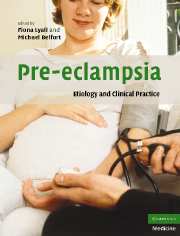Book contents
- Frontmatter
- Contents
- List of contributors
- Preface
- Part I Basic science
- 1 Trophoblast invasion in pre-eclampsia and other pregnancy disorders
- 2 Development of the utero-placental circulation: purported mechanisms for cytotrophoblast invasion in normal pregnancy and pre-eclampsia
- 3 In vitro models for studying pre-eclampsia
- 4 Endothelial factors
- 5 The renin–angiotensin system in pre-eclampsia
- 6 Immunological factors and placentation: implications for pre-eclampsia
- 7 Immunological factors and placentation: implications for pre-eclampsia
- 8 The role of oxidative stress in pre-eclampsia
- 9 Placental hypoxia, hyperoxia and ischemia–reperfusion injury in pre-eclampsia
- 10 Tenney–Parker changes and apoptotic versus necrotic shedding of trophoblast in normal pregnancy and pre-eclampsia
- 11 Dyslipidemia and pre-eclampsia
- 12 Pre-eclampsia a two-stage disorder: what is the linkage? Are there directed fetal/placental signals?
- 13 High altitude and pre-eclampsia
- 14 The use of mouse models to explore fetal–maternal interactions underlying pre-eclampsia
- 15 Prediction of pre-eclampsia
- 16 Long-term implications of pre-eclampsia for maternal health
- Part II Clinical Practice
- Subject index
- References
10 - Tenney–Parker changes and apoptotic versus necrotic shedding of trophoblast in normal pregnancy and pre-eclampsia
from Part I - Basic science
Published online by Cambridge University Press: 03 September 2009
- Frontmatter
- Contents
- List of contributors
- Preface
- Part I Basic science
- 1 Trophoblast invasion in pre-eclampsia and other pregnancy disorders
- 2 Development of the utero-placental circulation: purported mechanisms for cytotrophoblast invasion in normal pregnancy and pre-eclampsia
- 3 In vitro models for studying pre-eclampsia
- 4 Endothelial factors
- 5 The renin–angiotensin system in pre-eclampsia
- 6 Immunological factors and placentation: implications for pre-eclampsia
- 7 Immunological factors and placentation: implications for pre-eclampsia
- 8 The role of oxidative stress in pre-eclampsia
- 9 Placental hypoxia, hyperoxia and ischemia–reperfusion injury in pre-eclampsia
- 10 Tenney–Parker changes and apoptotic versus necrotic shedding of trophoblast in normal pregnancy and pre-eclampsia
- 11 Dyslipidemia and pre-eclampsia
- 12 Pre-eclampsia a two-stage disorder: what is the linkage? Are there directed fetal/placental signals?
- 13 High altitude and pre-eclampsia
- 14 The use of mouse models to explore fetal–maternal interactions underlying pre-eclampsia
- 15 Prediction of pre-eclampsia
- 16 Long-term implications of pre-eclampsia for maternal health
- Part II Clinical Practice
- Subject index
- References
Summary
Two-dimensional morphology of a three-dimensional organ
Histopathology of the human placenta is mostly based on the light-microscopical evaluation of paraffin sections. Therefore, the three-dimensional features of normal and pathological placental villi are usually described in terms of the two-dimensional description analysed by light microscopy. Remarkably, the two-dimensional findings often do not reflect the underlying three-dimensional characteristics of villi. This is particularly true when nuclear accumulations (syncytial sprouts, knots, bridges, Tenney–Parker changes) are involved which partly represent true sprouts, knots and bridges (Figure 10.1a,b); however, more often are the result of trophoblastic flat sectioning (Figure 10.1c) (Burton 1986a, b; Cantle et al., 1987; Kaufmann et al., 1987; Kuestermann, 1981).
The histological features of syncytial knotting have different origins
Historically, fungus-shaped, multinucleated protrusions of placental villous surfaces have been interpreted as (a) signs of villous sprouting (Boyd and Hamilton, 1970), as well as (b) signs of nuclear aging (Schiebler and Kaufmann, 1969; Martin and Spicer, 1973) and nuclear shedding (Ikle, 1964).
However, the interpretation became more difficult when it was reported that the multinucleated knots, sprouts and bridges found in two-dimensional paraffin sections very often did not reflect the three-dimensional characteristics of the structures that had been cut. In 1981 Kuestermann used serial paraffin sections to reconstruct the villous tree and found that the seeming sprouts and bridges are mostly flat sections of branches of the villous tree. Similar results were obtained by Burton (1986a, b, 1987) using plastic serial sections and by Cantle et al. (1987) and Kaufmann et al. (1987) using plastic sections of villi which were previously studied by scanning electron microscopy.
- Type
- Chapter
- Information
- Pre-eclampsiaEtiology and Clinical Practice, pp. 152 - 163Publisher: Cambridge University PressPrint publication year: 2007



